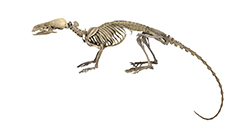Add to that list a new species of Hero Shrew recently discovered by Humboldt State University alum Bill Stanley (’89, Biology).
Native to central Africa, the rare mammal is considered an evolutionary anomaly thanks to its bizarrely durable spine.
Stanley, director of collections and a zoologist at Chicago’s Field Museum, was part of a team of international scientists who identified the unusual creature in a recent issue of _Biology Letters_.

Its defining feature? A series of interlocking vertebrae that render its spine four times more robust—relative to body mass—than any other vertebrate in the world.
The Hero Shrew's bizarre backbone has yet to be explained by science. But it has made the mammal a legend in the Democratic Republic of the Congo, where it was first discovered by explorers in 1910. The local Mangbetu people reportedly wear the shrew as a talisman to provide invincibility before battle. One account even claims that a full-grown man stood on a Hero Shrew’s back for 5 minutes and walked away, leaving the animal unscathed.

Although the latter report has not been confirmed, the mammal's resilience is no question. In a nod to its superior strength, Stanley and his colleagues named the new species _Scutisorex thori_, invoking Thor, the Norse god of strength.
The moniker also has a double meaning. _Scutisorex thori_ is a tribute to Thorvald “Thor” Holmes (’80 Biology), collections manager at HSU’s Vertebrate Museum. Stanley credits Holmes and others at the museum for igniting his career. "I take care of one of the world's largest mammal collections and I do that in large part because of Thor Holmes," he says. "It thought I would be a fitting tribute to mentor, a colleague and an inspiration."
Although the two men have kept in touch throughout the years, Holmes says he was "completely flabbergasted" when he heard the news. Only one other species of Hero Shrew—_Scutisorex somereni_—is known to exist in the world.
“I’m pretty sure this is the first and only species to be named after me,” he joked. “What else can I really say except thank you?”

In addition to naming the new species, Stanley and his colleagues offer a hypothesis as to why the shrew developed its strong spine in the first place.
They propose that the shrew’s super tough backbone allows it to access food in areas not accessible to other animals. Future research will involve testing that theory in a laboratory.
"Finding a new species and developing a hypothesis for the functional significance of its backbone is a double whammy," Stanley says. "It's going to open the door to a lot of research moving forward."